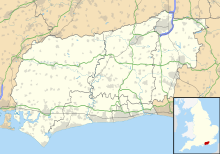RAF Thorney Island
RAF Thorney Island
|
|||||||||||||||||||
|---|---|---|---|---|---|---|---|---|---|---|---|---|---|---|---|---|---|---|---|
| Summary | |||||||||||||||||||
| Airport type | Military | ||||||||||||||||||
| Owner | Ministry of Defence | ||||||||||||||||||
| Operator | Royal Air Force | ||||||||||||||||||
| Location | Thorney Island | ||||||||||||||||||
| Built | 1938 | ||||||||||||||||||
| In use | 1938 - 1984 | ||||||||||||||||||
| Elevation AMSL | 10 ft / 3 m | ||||||||||||||||||
| Coordinates | 50°49′01″N 000°55′15″W / 50.81694°N 0.92083°WCoordinates: 50°49′01″N 000°55′15″W / 50.81694°N 0.92083°W | ||||||||||||||||||
| Map | |||||||||||||||||||
| Location in West Sussex | |||||||||||||||||||
| Runways | |||||||||||||||||||
|
|||||||||||||||||||
RAF Thorney Island is a former Royal Air Force station located 6.6 miles (10.6 km) west of Chichester, West Sussex, England and 7.1 miles (11.4 km) east of Portsmouth, Hampshire.
The airfield was built in 1938 for fighter aircraft and was involved in the Battle of Britain when it was attacked by the Luftwaffe on the same day as other stations such as RAF Ford and RAF Poling radar station. RAF Thorney Island was transferred to RAF Coastal Command for the protection of shipping and other various roles, and had its concrete runways laid in 1942. The station closed as an RAF airfield on 31 March 1976; however, the Royal Artillery re-opened the site in 1982.
As with many RAF Coastal Command airfields, a great variety of squadrons and aircraft were posted to RAF Thorney Island during World War II; in particular:
No. 22 Squadron RAF moved to the airfield on 10 March 1938 firstly using Vickers Vildebeest and then the Bristol Beaufort. It was possibly during this time when Flight Officer Kenneth Campbell won his Victoria Cross for a daring attack on the German battleship Gneisenau which was located in Brest harbour during April 1941 which unfortunately took his life. The squadron left on 8 April 1940 then came back to the airfield again on 25 June 1941 and stayed until 28 October 1941.
No. 48 Squadron RAF was present between 28 September 1938 and 10 October 1938 before returning on 25 August 1939 and leaving for the last time on 16 July 1940, both times using the Avro Anson.
...
Wikipedia

